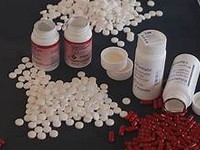Capreomycin
CLINICAL USE
Antibacterial agent in combination with other drugs:
DOSE IN NORMAL RENAL FUNCTION
Deep IM injection: 1 g daily (not more than 20 mg/kg) for 2–4 months, then 1 g 2–3 times each week
PHARMACOKINETICS
DOSE IN RENAL IMPAIRMENT
GFR (mL/MIN)
DOSE IN PATIENTS UNDERGOING RENAL REPLACEMENT THERAPIES
IMPORTANT DRUG INTERACTIONS
Potentially hazardous interactions with other drugsIncreased risk of nephrotoxicity and ototoxicity with aminoglycosides and vancomycin
ADMINISTRATION
Reconstition
Dissolve in 2 mL of sodium chloride 0.9% or water for injection. 2–3 minutes should be allowed for complete dissolution
Route
Deep IM injection
Rate of Administration
–
Comments
–
